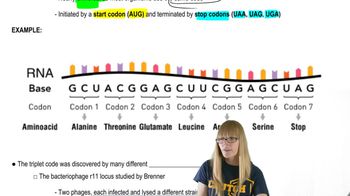Table of contents
- 1. Introduction to Genetics51m
- 2. Mendel's Laws of Inheritance3h 37m
- 3. Extensions to Mendelian Inheritance2h 41m
- 4. Genetic Mapping and Linkage2h 28m
- 5. Genetics of Bacteria and Viruses1h 21m
- 6. Chromosomal Variation1h 48m
- 7. DNA and Chromosome Structure56m
- 8. DNA Replication1h 10m
- 9. Mitosis and Meiosis1h 34m
- 10. Transcription1h 0m
- 11. Translation58m
- 12. Gene Regulation in Prokaryotes1h 19m
- 13. Gene Regulation in Eukaryotes44m
- 14. Genetic Control of Development44m
- 15. Genomes and Genomics1h 50m
- 16. Transposable Elements47m
- 17. Mutation, Repair, and Recombination1h 6m
- 18. Molecular Genetic Tools19m
- 19. Cancer Genetics29m
- 20. Quantitative Genetics1h 26m
- 21. Population Genetics50m
- 22. Evolutionary Genetics29m
11. Translation
The Genetic Code
Problem 24a
Textbook Question
Har Gobind Khorana and his colleagues performed numerous experiments translating synthetic mRNAs. In one experiment, an mRNA molecule with a repeating UG dinucleotide sequence was assembled and translated.
If the genetic code were overlapping rather than nonoverlapping, how would the result of this experiment be different?
 Verified step by step guidance
Verified step by step guidance1
Understand the concept of overlapping vs. nonoverlapping genetic code. In a nonoverlapping code, each nucleotide is part of only one codon, whereas in an overlapping code, a single nucleotide could be part of multiple codons.
Consider the mRNA sequence with a repeating UG dinucleotide: UGUGUGUG... In a nonoverlapping code, this sequence would be read as UGU, GUG, UGU, GUG, etc.
In an overlapping code, the reading frame would shift by one nucleotide for each new codon. For example, the sequence could be read as UGU, GUG, UGU, GUG, etc., but also as GUG, UGU, GUG, UGU, etc.
Analyze how the overlapping reading frame would affect the resulting polypeptide. Each nucleotide would contribute to multiple codons, potentially leading to a different sequence of amino acids.
Reflect on the implications of overlapping codes on genetic diversity and protein synthesis. Overlapping codes could result in more complex and varied proteins from a single mRNA sequence.
Recommended similar problem, with video answer:
 Verified Solution
Verified SolutionThis video solution was recommended by our tutors as helpful for the problem above
Video duration:
2mPlay a video:
Was this helpful?
Key Concepts
Here are the essential concepts you must grasp in order to answer the question correctly.
Genetic Code
The genetic code is a set of rules that defines how the sequence of nucleotides in mRNA is translated into amino acids, the building blocks of proteins. It consists of codons, which are groups of three nucleotides that correspond to specific amino acids. Understanding the genetic code is essential for interpreting how mRNA sequences dictate protein synthesis.
Recommended video:
Guided course

The Genetic Code
Overlapping vs. Nonoverlapping Code
In a nonoverlapping genetic code, each nucleotide is part of only one codon, meaning that the reading frame shifts after every three nucleotides. In contrast, an overlapping code allows for nucleotides to be shared between adjacent codons, potentially leading to different amino acid sequences. This distinction is crucial for predicting how changes in mRNA sequences affect protein translation.
Recommended video:
Guided course

The Genetic Code
Translation Process
Translation is the process by which ribosomes synthesize proteins based on the sequence of mRNA. During translation, tRNA molecules bring specific amino acids to the ribosome, matching their anticodons with the mRNA codons. The way the genetic code is structured—overlapping or nonoverlapping—directly influences the resulting protein's amino acid sequence and function.
Recommended video:
Guided course

mRNA Processing

 11:43m
11:43mWatch next
Master The Genetic Code with a bite sized video explanation from Kylia Goodner
Start learningRelated Videos
Related Practice

